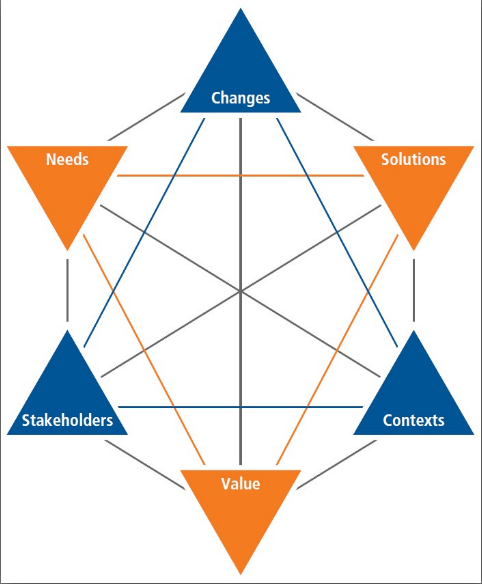In our continuing series on BABOK version 3 vs. version 2, we conclude with the two major additions made by IIBA: the BA Core Concept Model™ (BACCM) and an all-new section containing five perspectives on Business Analysis. This article provides a summary of the new BACCM, a practical definition of the six core concepts, and an example of each. This article also describes the new Perspectives and provides examples of the common elements in all the Perspectives.
BA CORE CONCEPT MODEL (BACCM)
One of the key changes in the BABOK® Guide version 3.0 is the introduction of the Business Analysis Core Concept Model (BACCM). This model defines the framework for all business analysis work, and can be applied across industries, methodologies, projects, and organizational cultures. It shows the interrelationships among six core concepts: Needs, Solutions, Changes, Stakeholders, Value, and Contexts. There is no order to these six concepts that can be read in a variety of different patterns. Let’s look at each of these six concepts and then some of the ways each relates to the others.
Figure 1 below, published by IIBA in the BABOK® Guide version 3.0, shows the BACCM.
Needs refer to business problems that require solving or opportunities that can be seized. Needs are satisfied by Solutions.
Solutions are the products and services that provide ways to take advantage of opportunities and solve business problems. Solutions are developed through Changes consisting of one or several projects, programs, or initiatives. Examples include installation of commercial software and changes to the current processes, development of a new medical device, creation of a marketing campaign, or implementation of new regulations.
 Figure 1: Business Analysis Core Concept Model
Figure 1: Business Analysis Core Concept Model
Changes are the steps involved in transforming Needs into Solutions. Note that the word “Change” is used in the BABOK® Guide in lieu of the terms “Project” and “Program.”
Stakeholders are individuals or groups that have Needs, an interest in the Solution, and/or are affected by the Changes.
Value. Solutions need to provide Value to the organizations and Stakeholders. If Solutions do not provide Value, they have not met the Need. Business analysis is really all about delivering Value to the organization.
Contexts are all those things that affect and are relevant to the Changes. This is the environment in which the Solution will be developed and includes such things as organizational culture, as well as the culture of the various countries that might be involved, languages, organizational process assets and environmental factors, constraints like weather, seasons, or other things happening at an organization or within a division or department.
Let’s look at an example of these interrelationships.
Need. A sponsor is concerned about losing market share to a competitor. One of the problems that contributes to this loss is the limited information provided by the set of Order reports she currently receives. Her Need, then, is the limited Order information inhibiting her ability to make good buying decisions.
Solution. After some analysis and a business case, the business analyst has recommended commercial business analytics software as a Solution. This is a complex Solution that will involve multiple projects addressing such things as processes, software, and new technology to name a few.
Changes. The Changes to the organization will be significant. The analysis of the current state and definition of the future state done during Strategy Analysis will need to be refined and expanded. Some of the Changes include designing new processes, purchasing new software, modifying data structures in existing interfacing applications, capturing new data, building technical ways to transition to the new software, and more.
Stakeholders. Stakeholders including buyers, merchandisers, advertising staff, distribution centers, retail store personnel, customer service specialists, several vendors, and many areas in IT will be affected globally.
Value. This Solution will provide Value to the sponsor, many Stakeholders, and the organization. The business case included a cost/benefit analysis which showed that although the costs were high, the organization would start seeing a benefit within a year. Several solution performance measures were identified during Solution Evaluation to help measure the realized value.
Contexts. Since this is a complex project with globally distributed Stakeholders, there are many Contexts that need to be considered. Each country’s laws and regulations, the various national cultures, as well as the different departmental cultures will affect the development of the Solution. For example and speaking generally, the distribution staff tends to be casual, the buyers more goal-driven and direct, and the advertisers more expressive. In addition, one of the facilities is in central Europe, which has recently experienced massive flooding. Finally, monsoon season is approaching India, where some of the technical and support staff are located.
Understandably not all Solutions and Changes are as complex as this one. This example was meant to provide an understanding of each of these six core concepts and how they fit together.
Perspectives
The BABOK® Guide Perspectives are focused areas that need to be addressed depending on the nature of the project. Each Perspective provides how business analysis work is completed and its unique characteristics on projects with these Perspectives:
- Agile
- Business Intelligence
- Information Technology
- Business Architecture
- Business Process Management (BPM)
Some projects will have multiple perspectives. A business analytics application, for example, might have elements from all five perspectives.
Each perspective is organized into five sections:
- Change scope (think project scope) includes such things as which areas of the organization are impacted and will be affected by the approach taken. For example, the Agile perspective alludes to a constantly changing scope. The BPM perspective contains four typical lifecycle stages and several methods to outline the scope.
- Business analysis scope includes the scope of the business analysis work, including which artifacts or work products will be produced and which stakeholders will be involved in the change. For example, the Agile perspective notes that the amount of rigor applied to documentation, a business analysis work product, is dependent on the nature of the project.
- Methodologies, approaches, and techniques. Each Perspectives might have some specific methodologies or approaches that are unique to that Perspective. Scrum, for example, is an Agile Methodology. Information Technology has its own development life cycles. As an example of a technique, Prioritization is listed as a general technique, but in the Agile perspective MoSCoW prioritization is listed as an Agile-specific type of prioritization.
- Underlying competencies include those that are most relevant to each perspective. They do not have to be unique and might be relevant to other Perspectives as well. For example, the Communications and Collaboration technique is listed as an underlying competency in the Agile perspective. Collaboration Games is listed as a general technique. Communications Skills is listed as a general underlying competency.
- Impact on Knowledge Areas shows a mapping of specific activities relevant to the Perspective to the BABOK® Guide tasks. For example, the Agile Perspective discusses the relationship to the Requirements Life Cycle Knowledge Area, stating that requirements are defined with increasing detail and that validation of requirements is done at the end of each iteration. The BI Perspective mentions overcoming barriers to utilizing new analytic tools and techniques in Solution Evaluation.
This article has provided a summary of the new BACCM and Perspectives with some examples to help decipher these new concepts. The overall series of articles gives an in-depth look at the new BABOK version 3. The new Guide represents a major increase in content and improvement over version 2. Our goal was to explain the major changes and additions, and to structure and simplify it. Please respond with your comments, questions, and any disagreements.
Don’t forget to leave your comments below.
About the Authors
Elizabeth Larson, PMP, CBAP, CSM, PMI-PBA is Co-Principal and CEO of Watermark Learning and has over 30 years of experience in project management and business analysis. Elizabeth’s speaking history includes repeat presentations for national and international conferences on five continents.
Elizabeth has co-authored five books on business analysis and certification preparation. She has also co-authored chapters published in four separate books. Elizabeth was a lead author on several standards including the PMBOK® Guide, BABOK® Guide, and PMI’s Business Analysis for Practitioners – A Practice Guide.
Richard Larson, PMP, CBAP, PMI-PBA, President and Founder of Watermark Learning, is a successful entrepreneur with over 30 years of experience in business analysis, project management, training, and consulting. He has presented workshops and seminars on business analysis and project management topics to over 10,000 participants on five different continents.
Rich loves to combine industry best practices with a practical approach and has contributed to those practices through numerous speaking sessions around the world. He has also worked on the BA Body of Knowledge versions 1.6-3.0, the PMI BA Practice Guide, and the PM Body of Knowledge, 4th edition. He and his wife Elizabeth Larson have co-authored five books on business analysis and certification preparation.



 Figure 1: Business Analysis Core Concept Model
Figure 1: Business Analysis Core Concept Model